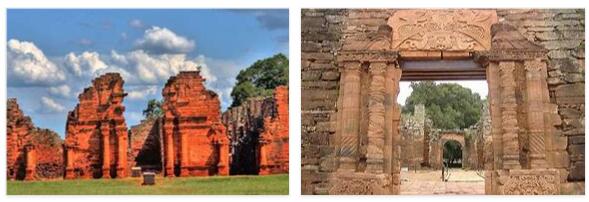Argentina Industries and Trade
Industries. – From what has been said we conclude that Argentina has an industrial production almost exclusively derived from agriculture and livestock, it is a country very rich in these products and has almost unique possibilities of being able to further develop production.
According to Anycountyprivateschools, some small industries existed in various regions, industries of a local nature, but the great foreign competition made them disappear almost completely, so that the country became an extraordinary producer of food and raw materials but subservient to European factories. With the increase of the population, both in quantity and in production capacity, and with the intervention of strong foreign or peasant capital, this state of things, for several decades, has been transforming: numerous industries make their appearance, and some of them is already powerful and in continuous progress.
It is true that the scarcity or lack of several mineral substances seriously hinders industrial development, but this is favored by the abundance of other materials and by state protectionism, which for some products makes its favorable influence felt, for example for sugar. At first industrial products were too affected by the intention of grossly imitating European production; the quality suffered and the public made a big difference between the foreign and the national product; but, over time, the quality improves and is often the same as that of imported goods.
The sugar industry that processes sugar cane is strong and has been enough for domestic consumption for several decades. The same is true for the wine industry, which is particularly concentrated in Mendoza and San Juan; it produces various common and fine types; the import has been reduced and we have come to export. The cereal area gives work to numerous mills and the textile industry has been progressing for some time, thanks also to the considerable production of good wool and the expansion of cotton cultivation. Florida is the leather industry with numerous large shoe factories located in the coastal region.
For meat, many saladeros soon arose, which are now of secondary importance, and are almost all found in Mesopotamia, along the Uruguay River. Much more advanced and rich is the refrigerator industry; they have large capital (British first, then North Americans) and prepare huge quantities of frozen and chilled meat for export; refrigerators largely replaced saladeros and are found especially in the province of Buenos Aires (along the Paraná and the Plata) and in Patagonia where sheep meat is processed. The dairy industry has also developed considerably, due to the abundance of livestock, and its products tend to improve more and more.
Although the Argentine economy is relatively recently developed, several of its products (food and raw materials) are of great importance in the world consumer market and this situation is tending to improve. The increase will not be able to stop, the stops will be only transitory, since it is a country with a growing active population, of almost exclusively Caucasian origin, whose action takes place on an immense territory, not all fertile is true, but with a very high percentage suitable for production and with great prospects of being able to intensify the yield of the cultivated part. In short, he is not exaggerating by saying that there are few countries that offer Argentina’s extraordinary possibilities for economic progress.
Trade. – For several decades, Argentine production has been oriented towards exports, while imports are also very active, so that international trade is impressive and always increasing. A general look at the country’s economy immediately highlights the nature of trade: food and raw materials are exported (wheat, meat, linen, wool, leather, etc.), industrial products are imported (agricultural, railway and industrial machinery, cars, fabrics, preserves, etc.) and some raw materials (coal and petroleum). Therefore Argentina becomes the economic complement of industrial countries such as Great Britain, the United States and Germany. With the first country mentioned, the exchanges are very high and almost balanced in terms of buying and selling; on the other hand, the United States exports much more than it imports, because to their character as a country of large industry, they combine that of a producer of enormous quantities of materials similar to Argentines. There is a notable exchange with Italy, from which he buys fabrics, cars, marble, preserves, etc.; an active commercial traffic exists also with Belgium, with France, with Brazil, with Mexico, with Spain and in varying proportions with almost all the countries of the world.
Communications and transport. – Streets. – A glance at the map of the Republic shows how the great western mountainous area greatly hinders communications. In fact, there are few roads with poor performance, and although now, despite the high cost, some comfortable ones are being built, the region is mainly mule track, and in the far north-west, bordering Bolivia, the llama it has not yet completely succumbed to animals and machines more suited to modern needs. Other regions have too large expanses of marshy land, constant or seasonal, with a direct negative influence on circulation. Furthermore, it must not be forgotten that the general scarcity of population combined with the vast surface of the country creates a serious problem; residents and circulation are two closely related terms of the same problem. In the pampeana area, flat and of considerable social and economic activity, the roads can be easily traced; but, given the nature of the soil, conservation is too often deficient, and this affects the cost of transporting goods. The increase in economic activity and the increasingly common use of cars will improve roads;
In Patagonia, where the railways are at the beginning of their development, communication with the wagons was too slow; but, in recent years, the car has brought about a great transformation in terms of speed and this serves as a stimulus to the social and economic life of that area.
Despite the deficiencies originating from the topography or the means of circulation, Argentina is far from the state it was in towards the middle of the last century when transport was slow, very slow – journeys from Buenos Aires to certain provinces lasted several months – uncomfortable and not always safe, if the itinerary was too close to the territories of the Indians. It is understood that progress has not been uniform throughout the Republic, since the differences between region and region are very numerous and decisive.












